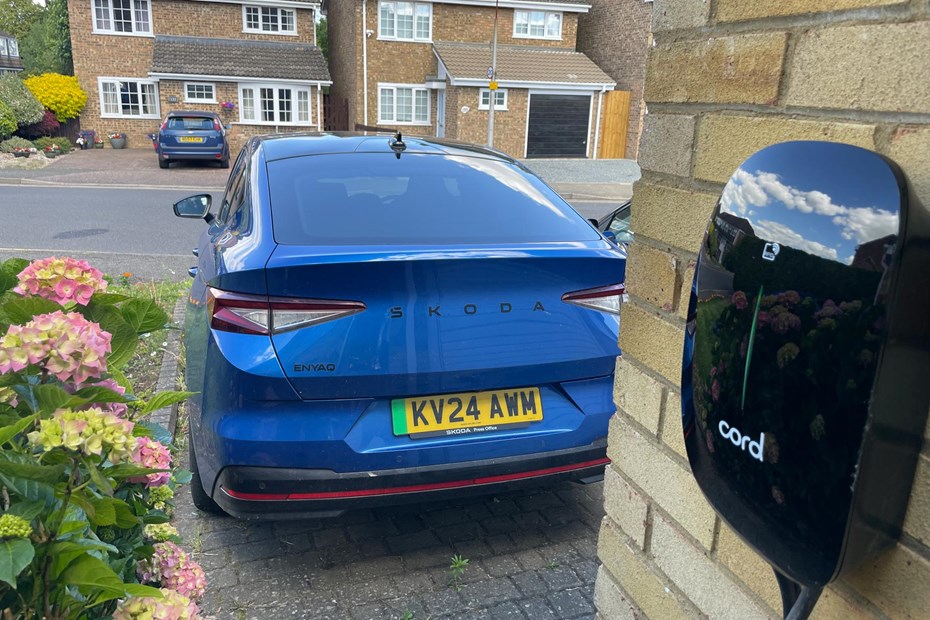Even as electric cars increase in mainstream visibility, there is a strong sense of ‘It’s easy if you know how’ about buying and owning one. Getting a home EV charger is a big barrier for many.
Filling up a petrol or a diesel car is fairly straightforward, but even if it wasn’t, most of us have grown up watching people go through the process. However, as EVs become more popular, the vast majority of people choosing to buy one will not only be doing it the first time themselves, they will also likely be the first of their immediate family to take the step.
Even after a decade and a half of writing about the new car and van market, this was certainly the case for me when it came to getting a home charging point installed. Plenty will scoff and say that this is my job, but I’ve spent almost eight years specialising in vans and pickups, and these are some way behind passenger cars when it comes to electric adoption.
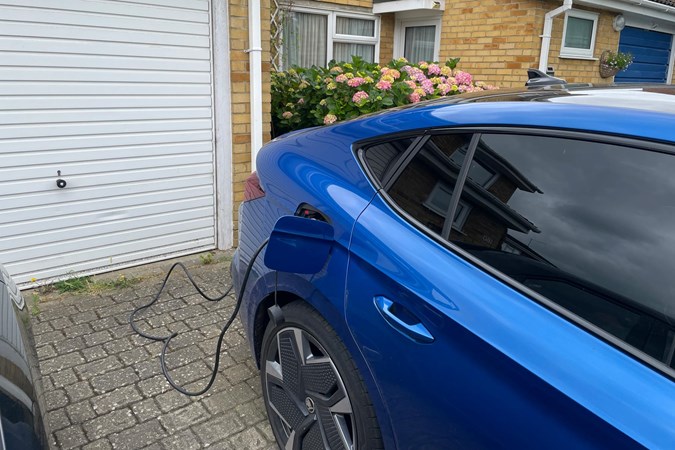
I also spent a large chunk of those years living in a flat with no dedicated off-street parking, so a charging point wasn’t an option anyway.
Now that I have moved and am fortunate enough to have my own driveway, it’s time to get connected.
Halfords’ hand holding
Part of the challenge with getting into the world of EVs is plenty of the companies are new ones and they don’t have much in the way of name recognition that would provide reassurance. The likes of Ohme, Pod Point, myenergie, Wallbox etc are all big, trustworthy and reassuring companies, but they are names that you might not come across without delving into the world of electric vehicles.
One name that will be familiar to plenty of motorists is Halfords, and the high-street store has now paired up with charging point company Cord as its preferred supplier. In short, that means that if you go into Halfords and ask about getting a charger, then it will be a Cord. Equally, you can only get a Cord through Halfords. Just as you can only buy certain types of bicycle at Halfords.
The other USP that Cord is offering is an extra degree of hand holding through the process, providing a bit more reassurance for those who are not confident in what they are doing.
Before you get a charging point installed, you need to check that your property is prepared for one. A modern new build might be all good to go, but an older or more idiosyncratic house setup might require a bit more rejigging of the setup.
To work out what needs doing, a survey is carried out, but in plenty of cases the installer will ask you to do that yourself, usually by taking a series of pictures of the relevant areas. In Cord’s case, though, an engineer comes around and does the survey for you. Much more reassuring for those who might already be intimidated by the prospect of taking a big step into a new world of technology and just want things to be as easy as possible.
Booking in
Getting the process going was fairly simple, and I was given a selection of different dates to pick from for the survey and the installation at the same time. This stretched a fair way into the future, so you didn’t have to be committing to an appointment in the next couple of days.
There wasn’t a subsequent email that confirmed which dates you had picked, so I made a note of which ones I had selected, but all this was moot as they contacted me to book in the precise time for the survey anyway.
Then that was it – I didn’t need to faff around taking with any pictures, as the engineer would come and work out exactly what needed to be done.
First visit
When James the engineer arrived it turned out it was going to be him that did both the inspection and the installation, which was reassuring as there would be less chance of things getting lost in translation. He worked across a range of different companies, being a general installer rather than a Cord specialist.
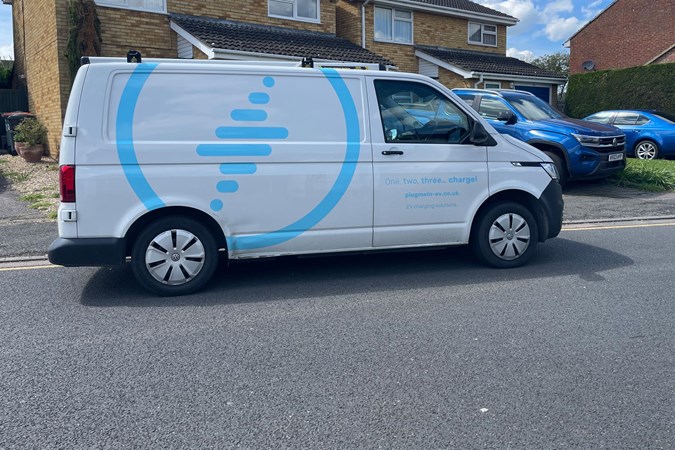
His check points were the main fuse, the earthing and desired location of the new point. He also wanted to check the Wi-Fi and how strong it was at this point. Everything measured up apart from the Wi-Fi, which was not quite as strong a signal as would be ideal. This seemed a little strange given the main router was on that side of the house, but ours sits upstairs, so it does have a little further to travel.
To mitigate this, he recommended getting a Wi-Fi booster in time for the installation date to make the signal a little stronger – one trip to Argos later and we were sorted.
All told, the survey was done within an hour, and that was with me asking annoying questions, so it would likely have taken less if I’d left him to it.
These questions were largely around our setup, as our house is one that was built in the late 1970s but not everything has been updated in that time. Consequently, our consumer unit (fuse box) is far from the newest, and this was a cause for concern from my perspective.
James explained that this wasn’t an issue, as what was going to be installed wouldn’t have any impact on our consumer unit and it is the main fuse that is more important. Ours met the required standard so happy days. The install was booked for a couple of weeks later.
Installation day
Knowing it was James turning up on the day of the installation made everything a lot easier, as I knew he’d know where to come, where our fuse box and electric meter was located and what his preferred tea order was.
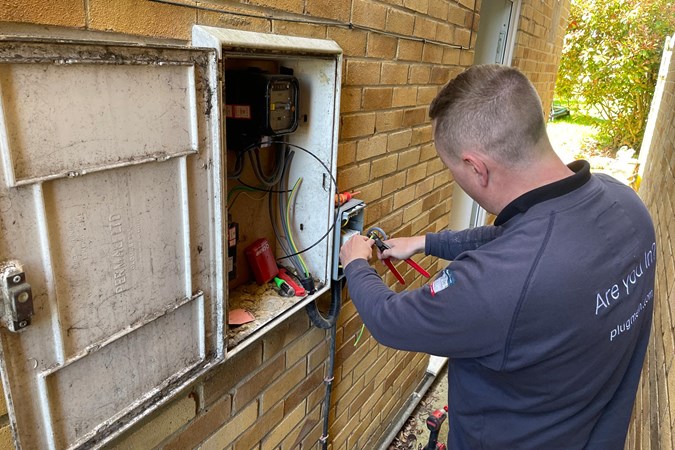
I can’t pretend to understand or be able to fully recount the technical process that James went through to set our new point up, so the following is purely from a consumer perspective, considering the impact it had on us and how long it took.
In short, not much and not long – about three hours in total, so it was all finished by lunchtime, with only a bit of noise from the drilling and a short period with the power off.
There are now two new features on the outside of our house, in the form of a new small grey box at the side of the larger white one that contains our electricity meter. This is where the charge point connects to our main electricity supply, and there are a few cables that are tucked down at ground level that lead to our new point, on the side of the house at the front.
Almost immediately I started not noticing either element, such was the neatness of the integration. The one element that baffles me is the little cap to go over the end of the plug – because the cable can be tucked into the unit, the cap just dangles down. Otherwise it’s just a neat, smart-looking little box on the house.
The first charge was an easy one too. When James set everything up he did all that was necessary to ensure it was connected to the internet and was ready to go even though I didn’t have an EV on the drive at the time. When I first went to plug it in it was a simple case of heading into the app to start it off and it automatically stopped once the car – Editor Keith’s Skoda Enyaq Coupe – was fully charged.
Gremlins in the process
It has been far from plain sailing, though. To start with, I had to sign off a document stating that, among other things, I had seen the warranty documents, but there were none in the paperwork that was handed over.
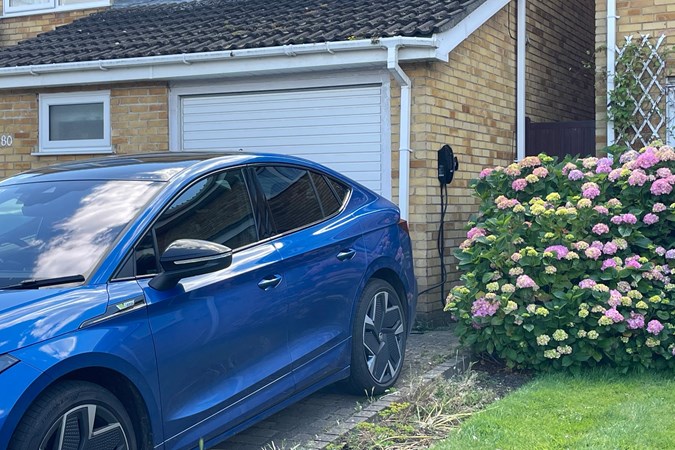
This felt like a slight disconnect in the process – the installation was carried out by a third-party company rather than Cord, and it was this company’s tick list I was being asked to approve. I managed to get a copy sent over to me by Cord in the end, but this was after I had said I had seen it. Cord promised me this would be addressed for future installs though.
Secondly, there was a period where my laptop was having trouble connecting to various applications and work-critical websites. This was eventually traced to the Wi-Fi extender, so this had to be switched off. Granted this is not the Cord’s fault, but it was another fly in the settling-in ointment.
I had also had my doubts about whether our slightly aged electrics would be ok to take a charger, and was surprised when the survey said they met the standards. However, I was told that while our 60 Amp home fuse was fine to deal with a charger, it might struggle if we have lots of things on at once, so it would be better to charge at night rather than over dinner while we are cooking, running the washing machine and putting the dishwasher on.
To upgrade it, we would have to replace the main fuse, which would then require updating of quite a few of the connecting wires – probably a total rewire of the house. While I wouldn’t expect Cord to do this for any customer, I was surprised that this was only mentioned at the end. It wouldn’t have changed my decision, but it might for some so it would been beneficial to know at the start of the process.
Finally, as part of the process to diagnose the internet issues, my router had to be replaced, which resulted in a new network name and password. As a result, the Cord is no longer connected to the internet.
It turns out that reconnecting it is not a simple process. I was expecting to pop into the app, head to settings and then do it in a few easy steps. Nothing could be further from the truth.
Instead, it is a long and convoluted process that requires you to, among other things, put your phone into airplane mode, connect to the back end of the charger and eventually reconnect. The guide to doing this is all written as if it is addressing the installer rather than the end user.
Now, I’m a fairly tech-comfortable sort, who can figure out most basic systems without having to delve into the manual, but I didn’t stand the beginning of a chance with this. And I dread to think how my 70-something mum would feel about it all, given she hasn’t connected her TV to the streaming services she can access because it ‘doesn’t seem worth the hassle.’
And before anyone starts on saying that such a tech-resistant customer is not who would be going for an EV, don’t forget the a) age demographic of new-car buyers and b) how long these buyers will be able to choose anything but an electric vehicle if they want to keep going for something brand new.
In short Cord might have made the installation wonderfully easy, but it takes more than that to make everything truly accessible.
How much does a home charger cost?
There are two options when it comes to choosing a Cord One, and it is simply a case of picking which length of cable you want – 5m or 7m. At the time of installation these were priced at £999 for the 5m one and £1,029 for the 7m, but these have since been reduced by £100 each to £899 and £929 respectively.
This is about standard for the industry, with alternatives such as the Ohme ePod and Home Pro currently at £949 and £999 respectively, the Hypervolt Home Pro 3 is £690 (but without installation) and the 7kW Pod-Point Solo 3S is £1,099.
Just so you know, we may receive a commission or other compensation from the links on this website - read why you should trust us.


